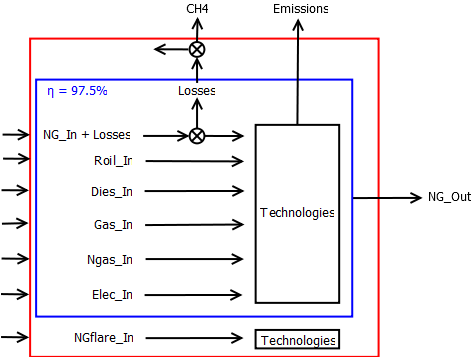3: Difference between revisions
(→Model) |
|||
| (4 intermediate revisions by the same user not shown) | |||
| Line 7: | Line 7: | ||
This process is modeled using shared inputs and two static amounts. Those were deducted from the Excel spreadsheet calculations.<br> | This process is modeled using shared inputs and two static amounts. Those were deducted from the Excel spreadsheet calculations.<br> | ||
[[File:3_model.png]] | [[File:3_model.png|thumb|right|500px|[[File:3_model.dia]]]] | ||
As it can be seen from the model the losses are accounted into the global efficiency of the process, but the Flared Natural Gas isn't. This is modeled the same way in Excel except that an "fake" Natural Gas input is added to the line "Feed Loss" in order to model the losses. | As it can be seen from the model the losses are accounted into the global efficiency of the process, but the Flared Natural Gas isn't. This is modeled the same way in Excel except that an "fake" Natural Gas input is added to the line "Feed Loss" in order to model the losses. | ||
Latest revision as of 18:01, February 24, 2012
NA NG Recovery
NA NG Recovery is calculated using an efficiency and fuel shares, basically we calculate how much input is necessary to the process and assign that to each input using the shares, except for what is considered to be the main input. The main input is defined by an amount of 1mmBtu + losses. Here we do not need any Feed Loss or Loss Factor as we define the inputs and output for all our processes. As the inputs and output are not fulls described in the Excel version, they need the loss factors and feed loss, but we decided to get rid of them in order to gain in simplicity for the users.
Model
This process is modeled using shared inputs and two static amounts. Those were deducted from the Excel spreadsheet calculations.
As it can be seen from the model the losses are accounted into the global efficiency of the process, but the Flared Natural Gas isn't. This is modeled the same way in Excel except that an "fake" Natural Gas input is added to the line "Feed Loss" in order to model the losses. In our case we just add that to the main input.
Calculations
The calculations discussed in more details on the page Processes_Calculations but here we are going to describe quickly how the inputs amounts are calculated. In this new version of GREET the inputs are defined as :
- 1019305 Btus for NG_In + Losses
- 1% for Roil_In
- 11% for Dies_In
- 1% for Gas_In
- 86% for Ngas_In
- 1% for Elec_In
- 7585 Btus for NGflare_in
So as we can quickly see, it is quite ambiguous to see what is the relationship between the efficiency of the process and all those inputs. In excel why was it decided to not account NGflare_In in the efficiency ? Usually we prefer to just define a process with it's inputs and outputs amounts, but the ones extracted from the Excel version are still organized like that.
So the calculations, first we are going to calculate what is called the . It represent how much energy is available to share among the inputs defined by a share :
From this one we are removing the main input which is defined as an amount within the efficiency group (The main input is accounted into the efficiency)
Now we can assign the values to the shared inputs :
Here we do not need to adjust the shares as it is done in Excel because the losses are already removed from in the variable
The input is not accounted into the efficiency and defined as a static amount










